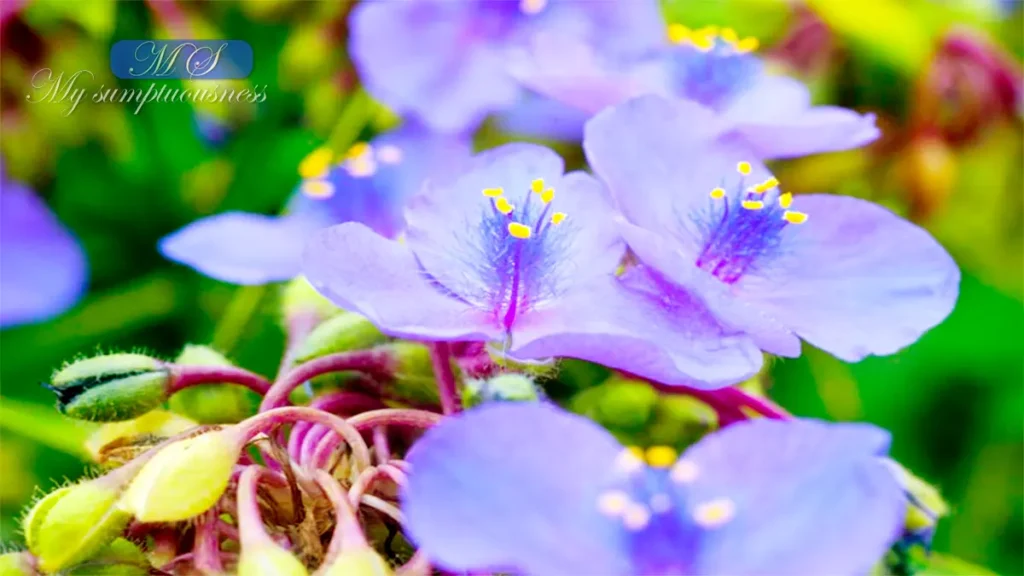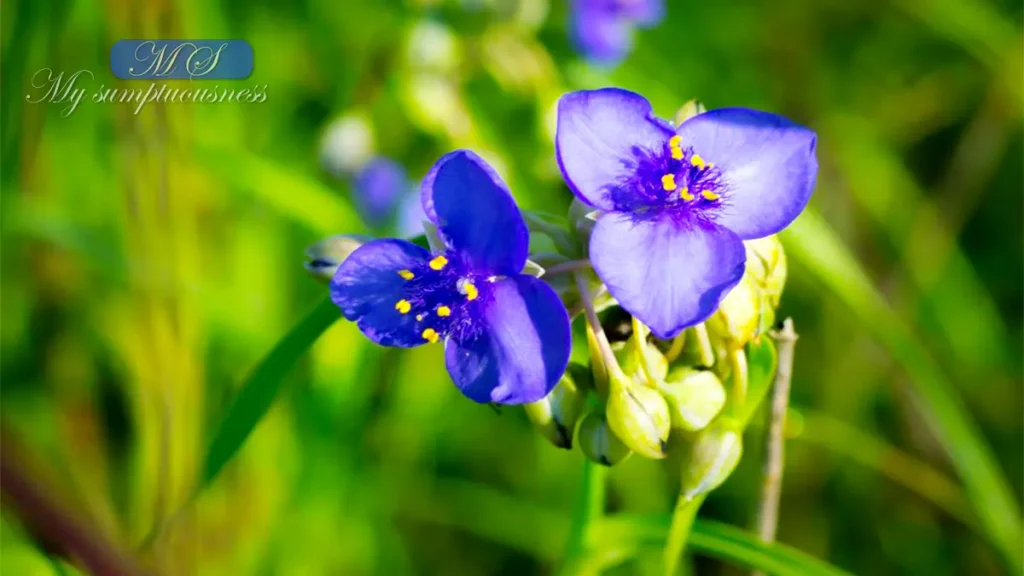Last Updated on 22 August 2023 by mysumptuousness.com
Spiderwort: A Colorful Garden Plant
Spiderwort is a colorful plant that you can find in many gardens. It’s called Spiderwort because its petals look a bit like spider legs. The pants of Spiderwort can be purple, blue, or pink, making them pretty to look at. People like to plant Spiderwort in their gardens because it’s easy to care for. You need to water it regularly and give it some sunlight. When you see Spiderwort in bloom, you’ll notice how the flowers open up in the morning and close as the day passes. So, if you’re looking for a simple and lovely plant to brighten your garden, consider adding Spiderwort to your outdoor space.
Exploring the Spiderwort plants

The Spiderwort flowers are fascinating and unique plant that captures the attention of many nature enthusiasts. Its name, “Spiderwort,” originates from its delicate petals that resemble the legs of a spider. This charming flower comes in various colours, from serene purples and blues to soft pinks. Its vibrant hues make it a delightful addition to gardens and landscapes.
Caring for Spiderwort Flowers: Nurturing and Cultivating the Charming Spiderworth
Caring for the Spiderwort plants involve a few simple yet crucial steps to ensure its health and vibrancy. This captivating plant, known for its spider-like petals and enchanting colours, thrives with a touch of attention and care.
1. Choosing the Right Location:
Spiderwort prefers moderate sunlight, so selecting a spot with partial shade is ideal. This ensures that the plant receives enough light to bloom while preventing it from getting scorched by direct sunlight.
2. Soil Preparation:
Well-draining soil is essential for Spiderwort’s well-being. Regular garden soil and organic compost mix create a fertile environment that allows water to drain effectively, preventing root rot.
3. Watering Routine:
Regular watering is crucial at the time of the growing season, keeping the soil moist but not waterlogged. Watering in the morning allows the plant to absorb moisture before the day’s heat sets in, reducing the risk of fungal growth.
4. Fertilizing Guidelines:
Spiderwort flowers benefits from a balanced, all-purpose fertilizer applied during its active growth period in spring. Following the recommended dosage on the fertilizer packaging ensures proper nourishment without overwhelming the plant.
5. Winter Care:
Spiderwort is generally hardy, but in colder climates, adding a layer of mulch around the base of the plant before winter provides insulation and protection from freezing temperatures.
6. Propagation Techniques:
Propagating Spiderwort can be done through division or cuttings. Dividing mature plants every few years helps maintain their vitality while taking cuttings from healthy stems in spring or early summer can lead to new plants.
Virginia Spiderwort: A Graceful Garden Flower

Virginia Spiderwort is a lovely flower you might see in gardens. It has pretty petals that can be purple, blue, or pink. This flower is unique because it opens up when the sun comes out and closes in the evening. Taking care of Virginia Spiderwort is easy. Give it water when the soil feels dry, and put it where it can get sunlight. People like having Virginia Spiderwort in their gardens because it adds beauty and charm to the outdoor space. Virginia Spiderwort could be a good choice if you’re looking for a simple and lovely flower to plant!
Ohio Spiderwort: A Charming Native Plant

Ohio Spiderwort is a delightful plant native to Ohio and other parts of North America. Its petals come in shades of blue, purple, and sometimes pink, creating a colourful display. Interestingly, Ohio Spiderwort blooms for a relatively short period, usually during late spring and early summer. Its flowers open in the morning and close by the afternoon, following the sun’s path.
Growing Ohio Spiderwort is relatively straightforward. This hardy plant thrives in various soil types and can tolerate both sun and shade, making it adaptable to different garden conditions. Regular watering and occasional fertilizing can help it flourish. Many people appreciate Ohio Spiderwort for its beauty and its role in supporting local pollinators like bees and butterflies.
In gardens and natural places, Ohio Spiderwort adds a touch of native charm and contributes to the ecosystem’s diversity. It’s effortless care and enchanting appearance make it a popular choice among gardening enthusiasts who want to embrace the beauty of local flora.
The Spiderwort Plant: Beauty in Simplicity
The Spiderwort plant, scientifically known as Tradescantia, is a captivating botanical gem found in gardens and natural settings. With its distinctive name derived from the spider-like appearance of its petals, this plant showcases an elegant simplicity that attracts many admirers.
Spiderwort blooms feature a range of enchanting hues, including shades of blue, purple, and pink. These blossoms open in the morning and gracefully close as the day progresses, an engaging behaviour that intrigues this already charming plant.
Caring for the Spiderwort plant is relatively uncomplicated. It thrives in well-draining soil and appreciates regular watering to maintain moisture levels. Placing it in a location that receives moderate sunlight ensures optimal growth. As a testament to its adaptability, the Spiderwort can flourish in various environments, making it a popular choice for novice and experienced gardeners. mysumptuousness
FAQs
It’s called Spiderwort because its petals look like spider legs. Another name for this flower is Tradescantia.
Spiderwort’s scientific name is Tradescantia. Some types are used in traditional medicine for minor health issues but are not widely used for medicinal purposes.
Most types of Spiderwort are not considered highly poisonous. Purple Spiderwort (Tradescantiapallida) might cause mild stomach discomfort if eaten in large amounts.
Handling Spiderwort shouldn’t cause skin irritation for most people. However, some individuals might be sensitive, so avoiding prolonged contact is good.
While some cultures have consumed certain types of Spiderwort in small quantities, it’s generally not a common edible plant. It’s better to enjoy its beauty in the garden.
Spiderwort can be grown indoors if given enough light. However, it’s more commonly found in outdoor gardens because it prefers natural sunlight.